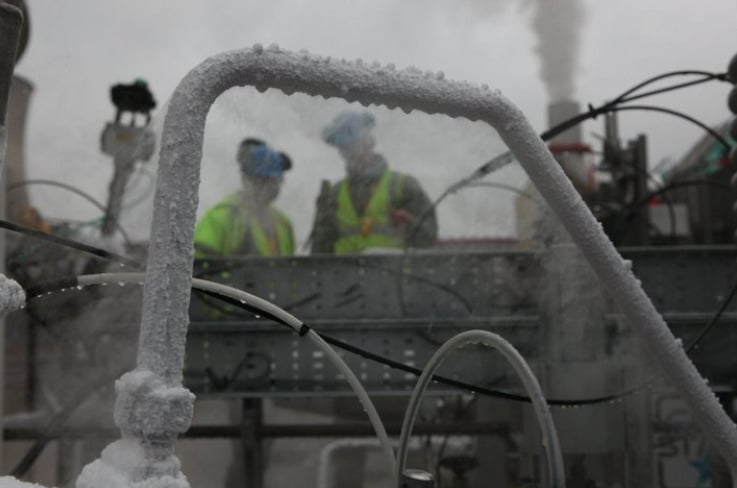Highview Power Storage, a UK company which makes energy storage systems based on liquid air technology, has said that work is well underway on a 5MW demonstration project in the north-west of England.
The project, at a gas generation landfill site in Greater Manchester, has been described as a pre-commercial demonstrator of the liquid air energy storage (LAES) technology, which will be used to turn waste heat into power. Highview, which signed a collaboration agreement with General Electric (GE) early last year, said that major components have been delivered and fixed to their platforms, marking the completion of the major plant installation phase.
According to Britain’s Institution of Mechanical Engineers (IMechE), LAES technology drives an air liquefier using excess electrical energy. The liquefied air, kept at low pressure, is then pumped at high pressure across heat exchangers which turn it into gas and drive turbines which in turn drive a generator.
Highview, along with recycling and waste management services company Viridor, was awarded £8 million in funding for the project through a competitive tender process by the UK government’s Department of Energy and Climate Change (DECC) in February 2014, with GE signing up as the LAES provider’s partner a month later.
The project is expected to have a 15MWh storage capacity and should be completed by the end of this year. Once installed it will be tested over a year of operation and should provide a range of applications. These include providing short term operating reserve (STOR), which involves providing either generation or demand reduction to the country’s National Grid electrical infrastructure within two hours of receiving a request from the grid.
GE’s ‘missing piece’
It will also support the grid through reducing peak electricity pricing, known in the UK as ‘triad’ management. Commercial and industrial electricity users have to pay charges based around late afternoon peak electricity in winter, with Highview’s system being used in the new trial to balance those peaks.
Finally, the Highview LAES will be used to test the technology’s suitability for use in grid balancing frequency regulation services, as seen in the PJM market in the US, where providers have used fast-responding energy storage to outcompete slower fossil fuel power stations.
Speaking to PV Tech Storage, Matthew Barnett, head of business development at Highview, said the company felt its technology could compete favourably with battery-based energy storage for larger-scale and longer duration applications. The system’s efficiency at smaller scales is “reasonable”, Barnett said, but gets better and more cost effective as it goes into the multiple megawatt scale, especially as – unlike batteries – which at the moment are projected to be in use for five, 10 or perhaps 20-25 years, Highview predicts that its storage systems can have a lifetime of 30 to 40 years, giving it a good lifecycle cost.
In many ways, Barnett said, the company sees its storage as more analogous to a modern version of pumped hydro storage and in theory is closer to that technology in terms of its capability. However, unlike pumped storage, which is relatively cheap but land intensive and requires specific topographical conditions i.e. a large reservoir on a hill with a lake beneath it, LAES “wouldn’t stand out in an industrial landscape” and would be “no more intrusive than a generator or diesel backup genset”.
On the question of warranties and how Highview could guarantee performance of the system, Barnett explained that the UK project will serve as a reference project for insurers, with Highview able to leverage equipment suppliers such as GE and their internationally renowned name, this would support the underwriting of a project.
GE’s interest came at a point when the US company was diversifying into a number of new technologies, including in the energy storage space, when it came to see Highview as a “piece missing” from its portfolio, Barnett said. The systems use so-called “off-the-shelf” components from suppliers including heat exchanger firm Heatric and cryogenic storage tanks by BOC as well as GE turbines and generators. GE was additionally drawn by the fact that it did not need to develop hardware, Barnett said. Incidentally, GE delivered its largest energy storage system to date last week, a 30MW lithium-ion battery project in California.
Finally, on the topic of global markets that Highview sees as most interesting, Barnett said the US was obviously of interest as an early adopter of storage at large scales, both to accommodate renewables and to balance the grid. Further to that, large-scale industrial operations in any region where storage could lower energy costs or help reduce emissions would also be addressable markets for the company, he said.





